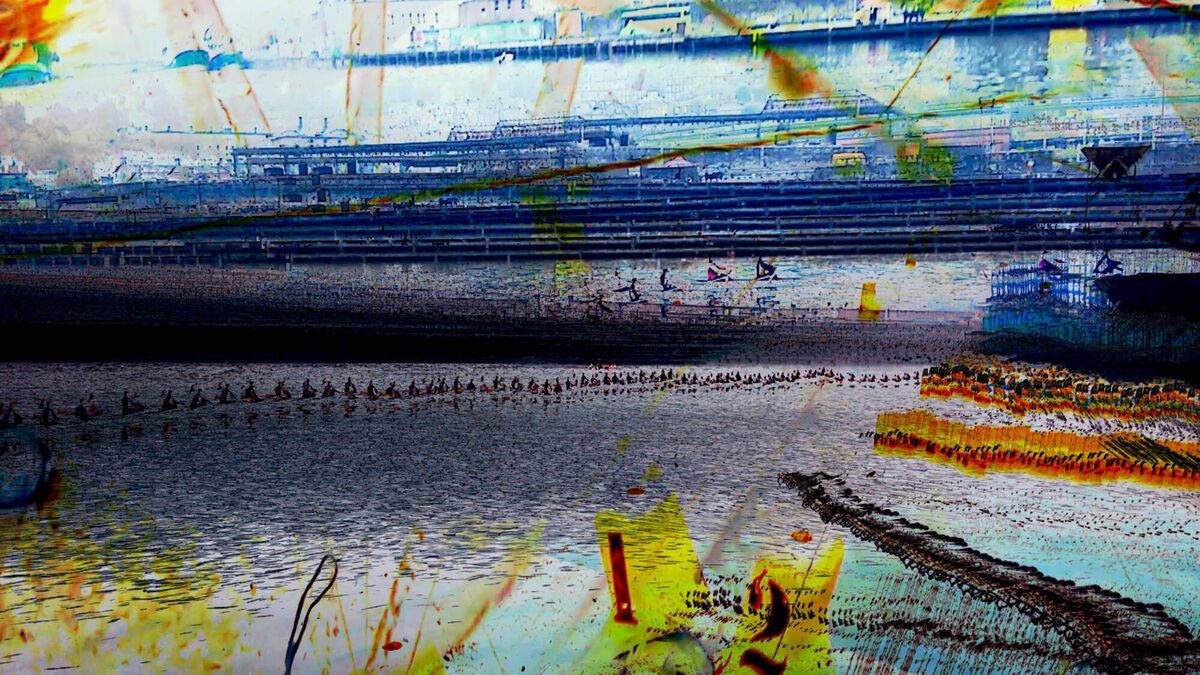Stuart Neilson: 'At Singer’s Corner in Cork, people are walking across a rectangular city design'

Stuart Neilson's work is currently included in the virtual Venice Architectural Biennale
The Bayeux Tapestry is 70 metres long, and 50cm tall. To view it, you normally have to walk its length, taking in the ancient tale scene by scene. So how would it be possible to view it in its entirety, all at the same time?
Dr Stuart Neilson hit on an ingenious solution to the unique conundrum he had set himself: “The problem was, how do you take something that’s so long and compress it so you can see it all at the same time? I took it and made it into a spiral, so that you can see it on the same page.”
Neilson later applied this technique to some of his slit-scan images of Cork city: the entirety of Patrick Street, filmed from a car, rolled up in a spiral.
Other digital artworks Neilson has produced have a similarly distinctive combination of technical tinkering and a decidedly idiosyncratic worldview, where beauty is found in the regularity of patterns.
Neilson captures the flight paths of birds in composite images taken from GoPro footage. Or makes 'heat-maps' of how humans negotiate pedestrian crossings, observing a curious feature of our built environments as he does so.
“The heat-maps show the desire-lines people make,” he says. “At Singer’s Corner in Cork, people are walking across a rectangular city design, but they’re all walking in curves: coming out of the English Market and maybe going up to the Centra on the other side. No-one’s walking in straight lines. It creates lovely images of the way people want the city to be, and the way the designers made it. And there’s a conflict between the two.”
Neilson’s observations have implications for how we design public spaces: having been diagnosed as an adult with Asperger’s Syndrome himself, he’s acutely aware of the impacts of architecture and design on the management of his own condition.
“When I go in somewhere, I need to know I’m going to be safe and so I like to go to the corner,” he says. “In Eason, they used to have the accountancy books in the corner, and I’ve no interest in accountancy but I would go in there if I felt close to a meltdown. It was my safe space. Then, about 15 years ago, they revamped and took the corners out and rounded them off with curved plywood, because the corner space was inactive.
“The whole idea was to create an architecture where you are always in the way, so you are encouraged to move. The worst examples of this are places like Sostrene Grene and Tiger, where you’re in a zigzag maze where you can’t stop: it’s designed to make sure there’s continuous flow and purchase.”

Neilson’s PhD is in mathematical modelling of disease, but he has written extensively about his experience of autism, and lectured on a Certificate in Autism Spectrum studies in the adult education centre in UCC.
Yet he wasn’t diagnosed with Asperger’s Syndrome until 45. Neilson was born in Cairo, and spent parts of his childhood in Pakistan and Ethiopia before settling in the UK. He talks frankly about a difficult childhood.
“I was called ‘educationally subnormal’ and ‘remedial’, which were the terms back then,” he says. “I spent my schooling in detention and being hit with a ruler or a strap: corporal punishment was abolished the year after I left school.”
His difficulties persisted into adulthood, through his move to Cork 23 years ago, when his wife got a job with a technology company here.
“Since I was a teenager, I was labelled neurotic or oversensitive,” he says. “All of that came to a head in about 2000, when I was harassed at work. I ended up seeking counselling and became very depressed.”
A suicide attempt that nearly claimed his life saw him spend time in the psychiatric ward of the Mercy Hospital, where a psychologist finally spotted that much of his experience could be explained by a diagnosis of Asperger’s Syndrome, the autism spectrum condition associated with high functionality.
“My wife immediately said, ‘oh yes, this is you.’” he says. “So I had an assessment: three months of tests, and he interviewed my parents about my childhood. It made a huge difference to me. Things like the sensory overload in a shop, I know what’s happening now. If I start feeling anxious, I know that’s my response to the stimuli.”
Neilson’s creative view of built environments and how we navigate them are now a part of the Venice Architectural Biennale.
Egyptian-Canadian architect Magda Mostafa specialises in designing autism-friendly spaces. Her ASPECTSS design framework of seven elements (Acoustics, Spatial Sequencing, Escape Space, Compartmentalisation, Transitions, Sensory Zoning, Safety) has been used to make UCD an autism-friendly university, as well as to design UCC’s Calm Zone.
She has selected seven of Neilson’s composite images to accompany her exhibition in Venice this year.
- Stuart Neilson’s work, as part of Magda Mostafa’s exhibition, Autistic Imaginaries of Architectural Space: the world from an Autistic Lens, at the Palazzo Bembo, as well as online at virtual Venice Architectural Biennale 2021, is on display until November 21




